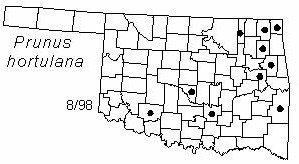Small tree to 6 m (20 ft) tall and 15 cm (6 in) diameter. Bark thin, scaly, dark brown. Twigs thick, stiff, glabrous, dark red-brown, sometimes ending in a spine. Buds very small, scaly, light brown, with no end bud. Leaves narrowly ovate to lanceolate, 7-11 cm (2.8-4.2 in) long and 2-3 cm (0.8-1.2 in) wide, acuminate, blunt or rounded at base, finely serrate, shiny dark green above, pale green and hairy (at least on veins) below. Petioles slender, with a few gland-dots near the leaf blade. Flowers in clusters of 2-4 appearing with the leaves in early Spring, white, 13-15 mm (0.5-0.6 in) in diameter. Fruits rounded drupes 2-3 cm (0.8-1.2 in) diameter, red or yellow when ripe, edible, maturing in early Fall.
Distribution: Native to an area from southern Ohio southwest to eastern Kansas and northeastern Oklahoma.
Habitat: Moist, well-drained soil in upland forest and along streams.
NWI status: none
Comment: This species has been domesticated and numerous cultivars have been developed. As a result of cultivation, it has spread widely beyond its native range. Prunus is the old Latin name for the European plums; hortulana means "of gardens" and refers to domestication of the species.
Distribution in Oklahoma: 
BACK
NEXT
RETURN TO INDEX
Last update: 9/15/99
 Go to Oklahoma Biological Survey Home Page
Go to Oklahoma Biological Survey Home Page
 Disclaimer
Disclaimer